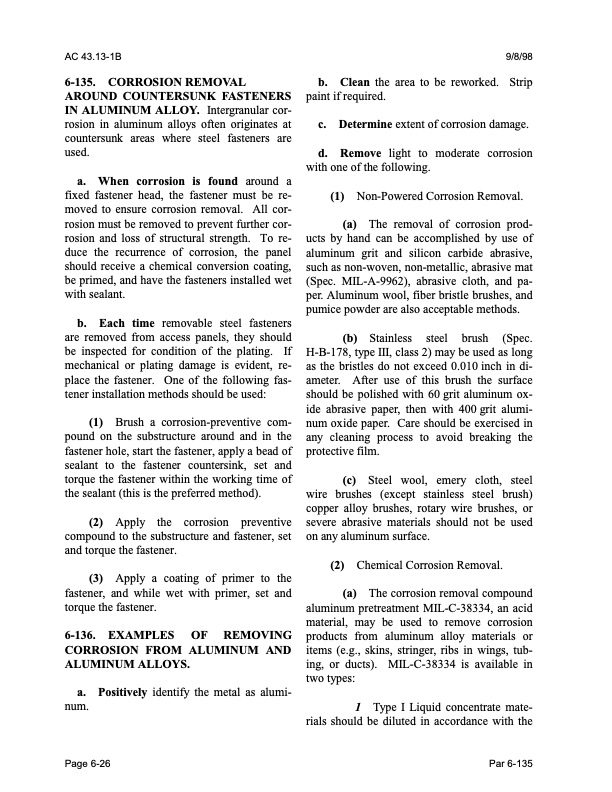
PDF Publication Title:
Text from PDF Page: 296
AC 43.13-1B 9/8/98 6-135. CORROSION REMOVAL AROUND COUNTERSUNK FASTENERS IN ALUMINUM ALLOY. Intergranular cor rosion in aluminum alloys often originates at countersunk areas where steel fasteners are used. a. When corrosion is found around a fixed fastener head, the fastener must be re moved to ensure corrosion removal. All cor rosion must be removed to prevent further cor rosion and loss of structural strength. To re duce the recurrence of corrosion, the panel should receive a chemical conversion coating, be primed, and have the fasteners installed wet with sealant. b. Each time removable steel fasteners are removed from access panels, they should be inspected for condition of the plating. If mechanical or plating damage is evident, re place the fastener. One of the following fas tener installation methods should be used: (1) Brush a corrosion-preventive com pound on the substructure around and in the fastener hole, start the fastener, apply a bead of sealant to the fastener countersink, set and torque the fastener within the working time of the sealant (this is the preferred method). (2) Apply the corrosion preventive compound to the substructure and fastener, set and torque the fastener. (3) Apply a coating of primer to the fastener, and while wet with primer, set and torque the fastener. 6-136. EXAMPLES OF REMOVING CORROSION FROM ALUMINUM AND ALUMINUM ALLOYS. a. Positively identify the metal as alumi num. b. Clean the area to be reworked. Strip paint if required. c. Determine extent of corrosion damage. d. Remove light to moderate corrosion with one of the following. (1) Non-Powered Corrosion Removal. (a) The removal of corrosion prod ucts by hand can be accomplished by use of aluminum grit and silicon carbide abrasive, such as non-woven, non-metallic, abrasive mat (Spec. MIL-A-9962), abrasive cloth, and pa per. Aluminum wool, fiber bristle brushes, and pumice powder are also acceptable methods. (b) Stainless steel brush (Spec. H-B-178, type III, class 2) may be used as long as the bristles do not exceed 0.010 inch in di ameter. After use of this brush the surface should be polished with 60 grit aluminum ox ide abrasive paper, then with 400 grit alumi num oxide paper. Care should be exercised in any cleaning process to avoid breaking the protective film. (c) Steel wool, emery cloth, steel wire brushes (except stainless steel brush) copper alloy brushes, rotary wire brushes, or severe abrasive materials should not be used on any aluminum surface. (2) Chemical Corrosion Removal. (a) The corrosion removal compound aluminum pretreatment MIL-C-38334, an acid material, may be used to remove corrosion products from aluminum alloy materials or items (e.g., skins, stringer, ribs in wings, tub ing, or ducts). MIL-C-38334 is available in two types: 1 Type I Liquid concentrate mate rials should be diluted in accordance with the Page 6-26 Par 6-135PDF Image | AFS-640

PDF Search Title:
AFS-640Original File Name Searched:
ac_43.13-1b_w-chg1.pdfDIY PDF Search: Google It | Yahoo | Bing
5,000 BF Shipping Container Lumber Dry Kiln For Quality Lumber The 5,000 BF container kiln consists of one 40 foot high-cube aluminum shipping container... More Info
Shipping Container Lumber Dry Kilns by Global Energy Global Energy designed and developed the container kiln back in 1991. The purpose is to give access to portable sawmill owners, furniture makers, and small business the value added profit of dry kiln lumber and quality hardwoods... More Info
Vacuum Kiln Conversion Kit for Lumber and Wood Dry Kilns Convert your existing conventional dry kiln into a fast drying vacuum kiln. Similar to vacuum bagging in the boat building and aircraft industry, we have come up with a proprietary process which allows you to build a very simple vacuum kiln at a fraction of the price, and without the intensive conventional metal chamber structure... More Info
Vacuum Pump Cart System for Bagging Clamping Wood Drying and more Vacuum Cart with 2HP Pump and Dual Pistons with multiple multiplex vacuum ports and liquid reservoir... More Info
Vacuum Bagging Basics Vacuum bagging is a method of clamping, which has traditionally been used in the composites industry, but can also be used for vacuum drying materials, including wood products... More Info
| CONTACT TEL: 608-238-6001 Email: greg@globalmicroturbine.com | RSS | AMP |